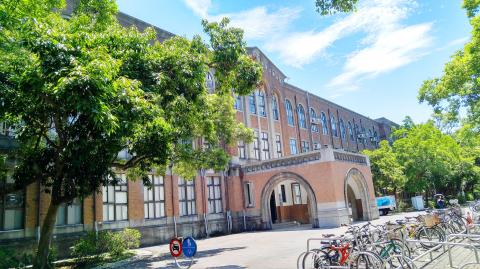In the imperial era, Japan founded nine imperial universities, of which seven were located in mainland Japan and two were in Japan’s overseas colonies. Taiwan’s first comprehensive university, Taihoku (the Japanese pronunciation of Taipei) Imperial University, was one of them.
During its establishment, the name “Taiwan Imperial University” was considered, but to prevent people from misunderstanding the name as meaning the “University of the Empire of Taiwan,” it was eventually named after the city in which it was located, hence Taihoku Imperial University. In fact, of the nine imperial universities, six were named after cities, such as Tokyo Imperial University and Kyoto Imperial University.
It was initially decided that Taihoku Imperial University would only have medical and agricultural departments, but then governor-general of Taiwan Izawa Takio insisted against all odds that the new university should be a comprehensive one. On March 16, 1928, Taihoku Imperial University, the first ever comprehensive university in Taiwan, was inaugurated and Japanese historian Taira Shidehara was appointed as the school’s first president.

Photo: Ethan Zhan, Taipei Times
照片:台北時報詹豐造
By 1944, Taihoku Imperial University had five schools, including the School of Liberal Arts and Political Science, the School of Science, the School of Agriculture, the Medical School and the School of Engineering, with 394 students, of whom, 277 were Japanese and 117 Taiwanese. Its library collection was ranked third among Japan’s nine imperial universities.
Taihoku Imperial University is now known as National Taiwan University. Its campuses are so vast that they account for one hundredth of Taiwan’s total land area. However, beginning from the 1980s, the school demanded that campus buildings should be built with common features, resulting in a striking resemblance between school buildings which has caused many people to become lost. Since Taiwan began holding direct presidential elections, four presidents have come from the school’s alumni, including incumbent President Tsai Ing-wen.
Translated by Ethan Zhan
日本在帝國時期共設立了九所帝國大學,七所在日本本土,兩所在海外殖民地。臺灣最早的綜合大學——臺北帝國大學——便是其中之一。
創校時,原本考慮將臺灣這一所命名為「臺灣帝國大學」,但為了避免造成誤會,被解讀成「臺灣帝國的大學」,因此決定以城市命名,是為「臺北帝國大學」。事實上,九所帝大中,有六所便是以城市命名的,譬如東京帝大、京都帝大。
原本臺北帝大定位為僅有醫學部、農學部的大學,但時任臺灣總督的伊澤多喜男力排眾議,決定將臺北帝大定位為綜合大學。一九二八年三月十六日臺北帝大開校,是臺灣第一所綜合大學,首任校長是日本歷史學家幣原坦。
至一九四四年時,臺北帝大已有五個學部,包括文政、理學、農學、醫學、工學,學生共三百九十四人,其中二百七十七名為日本人,一百一十七名為臺灣人。當時臺北帝大圖書館的館藏量在日本全國九所帝大中排名第三。
如今,臺北帝大更名為國立臺灣大學,校地廣大,佔臺灣總面積的百分之一。不過,由於一九八零年代開始,台大規定校內建築要有共通特性,因此校內建築相似度過高,造成不少人在校園內迷路。臺灣自從總統直選後,有四位總統都是出自台大,包括現任總統蔡英文。(台北時報詹豐造)

Whether they are a Siamese, Persian, Maine Coon, or Domestic Shorthair, there are hundreds of millions of cats living with people around the world. But despite their popularity as pets, the history of cat domestication has remained difficult for scientists to decipher. A new genome study is providing some insight into the matter by determining the timing of a key milestone in feline domestication - the introduction of domestic cats into Europe from North Africa. Domestic cats pounced into Europe roughly 2,000 years ago in early imperial Roman times, the researchers found, probably thanks to maritime trade. Some of these furry trailblazers

You’re half-asleep with your head resting on the desk during your lunch break. All of a sudden, your leg kicks violently, your head snaps up, and you’re wide awake in a split second. This __1__ sensation is called a “hypnic jerk,” a common phenomenon that strikes just as your body starts to relax, but your brain mistakenly hits the panic button. A hypnic jerk is an involuntary muscle spasm that usually occurs during the __2__ from wakefulness to sleep, especially during the early stages of sleep. As the body begins to relax, muscles loosen and breathing slows down. One

In English, “name idioms” are part of what makes English fascinating. Let’s put a few examples under the microscope. Doubting Thomas This expression stems from the Bible. Thomas, one of Jesus’s disciples, refused to believe Jesus had been resurrected from the dead. He declared he wouldn’t accept it until he could see the nail marks in Jesus’s hands and touch his wounds himself. Today, this idiom refers to someone who won’t believe something without concrete evidence. For instance, if your friend’s expertise is reliable, but you’re still suspicious, you might be a “doubting Thomas.” Smart Aleck The origin of this phrase likely comes from

Scientists at Argentina’s Marambio Station in Antarctica have detected high levels of ammonia gas in the air near an “Adelie penguin” colony. The ammonia, released from nitrogen-rich penguin guano, reacts with sulfur compounds emitted by oceanic plankton to form aerosol particles. These particles boost cloud formation and can sometimes lead to fog. Scientists found that even after the penguins left the area, the remaining guano continued to give off significant amounts of ammonia. Clouds created by the guano can influence the local climate by either reflecting sunlight or trapping heat, depending on environmental conditions. In other words, penguin waste